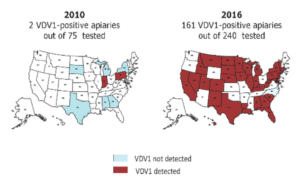[Editor’s note: Karen Rennich is the Project Manager for Bee Informed Partnership and APHIS National Survey, working out of University of Maryland’s Entomology Department. Among other things, they are studying the Varroa destructor mite, which a consensus of entomologists believe carries viruses that are the primary threat to bee health, rather than pesticides. This study provides further documentation of the dramatic spread of a particularly lethal form of a virus carried by the mite.]
Our University of Maryland lab has been leading the APHIS National Honey Bee Pest and Pathogen survey since 2010. During those years, we have processed thousands of samples from across most states for nosema spore load, Varroa load, pesticides, and viruses with the primary goal to survey whether exotics, not known to be in the US, are here or not. Secondarily, but almost as importantly, we also use the survey results to establish a nationwide honey bee health baseline
…
Dr. Eugene Ryabov, working at USDA-ARS with Dr. Jay Evans, decided to take a look into our archive freezer with the intent of re-processing those archived samples for VDV1. And we are glad that he did. After doing a sweep of 2016 samples, he found VDV1 in >64% of all samples, making it just less prevalent and second only to Deformed Wing Virus (currently found in ~90% of all colonies). Reaching further back into that freezer, Dr. Ryabov found that only 2 colonies were positive from our 2010 survey samples – 1 in Indiana and 1 in Pennsylvania, and that temporal snapshot [below] shows the spread of this virus in just 6 years.

The GLP aggregated and excerpted this article to reflect the diversity of news, opinion and analysis. Read full, original post: Varroa Destructor Virus-1: It’s here…































